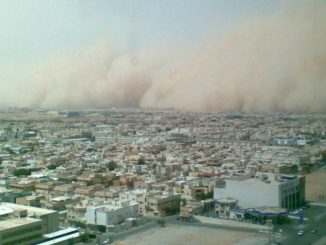As we head into Switzerland on my father and grandparents’ 1954 Continental road trip, Puffins will be horrified to hear that not only was that year a World Cup year but that the tournament was being held in Switzerland. There really is no escape. Should we pretend it’s not happening until another instalment? I think we should.
Our first photographs are in the east of the country having travelled along the Venosta Valley via the Hotel Posta at Spondigna in Northern Italy, home of the Alpine car rallies and holiday destination of the nefarious M. de Tourville whose poor wife (more properly a rich wife, which proved her demise) was pushed to her death over a nearby mountain precipice. But just before we leave Spondigna we must dwell upon this photograph, captioned ‘Italian Mondial’.
FB Mondial were founded in 1929 in Milan and are best known for dominating the Motorcycle World Championships between 1949 and 1957 during which time they won five rider and five manufacturer World Championships.
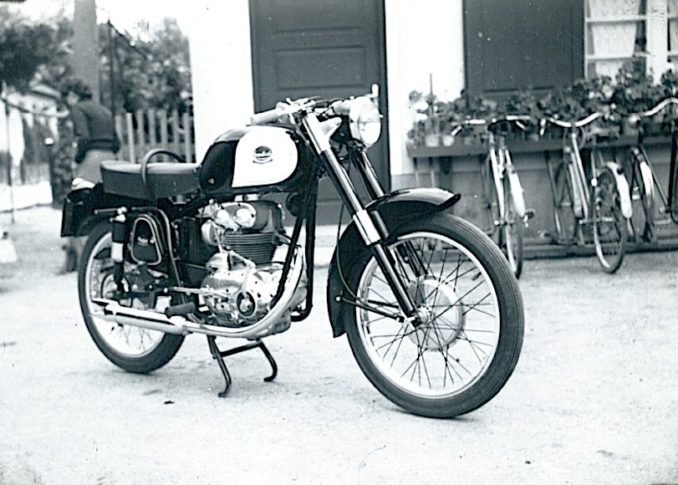
© Always Worth Saying 2022, Going Postal
The handsome model pictured above is a 1954 200cc Extralusso. A quick scout about on the internet shows that in the modern day a restored version can be yours for around £8,000.
One side of the Venosta valley is defined by the River Adige, the other, southern, by the River Rom much of which runs in a vineyard irrigating and flood-defying Roman-straight ditch. A few miles out of Spondiga, we leave the Adige and follow the Rom southwest towards the Swiss border which is reached at Tubre.
Looking at the present border crossing via Street View, it bears no resemblance to the family album photograph. The kind of standard issue Italian customs buildings we saw at the border with Austria at Brenner predominate but obviously pre-date the 1954 trip. You can have a look around here.
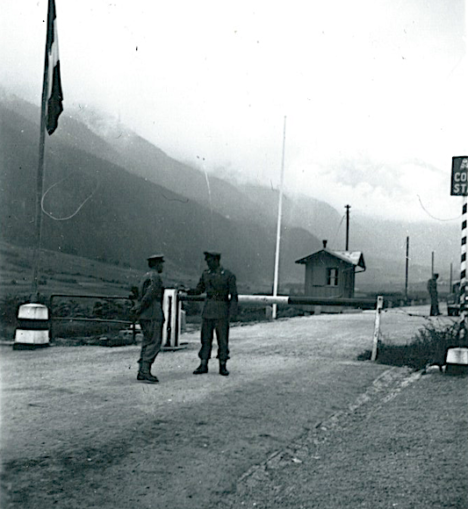
© Always Worth Saying 2022, Going Postal
There is no Street View on the Swiss side near the frontier which doesn’t help. We are left to assume that the family jalopy progressed into Switzerland via a secondary route near to Tubre and travelled through the countryside pictured below in what the caption on the photograph describes as ‘Cesvenna’. The Sesvenna Alps are a group of mountain ranges visible to the north of our road.
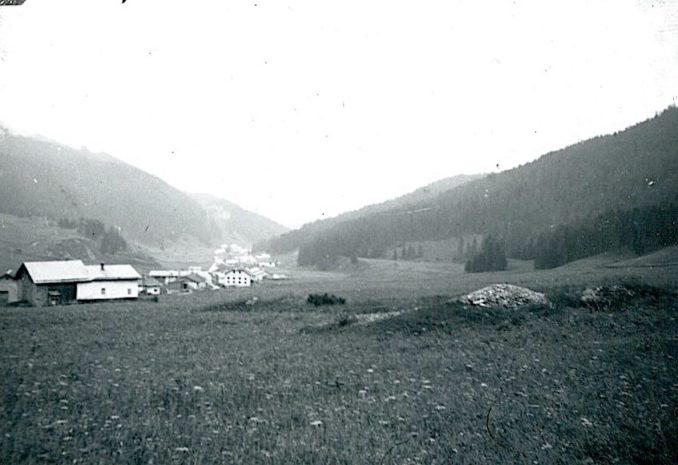
© Always Worth Saying 2022, Going Postal
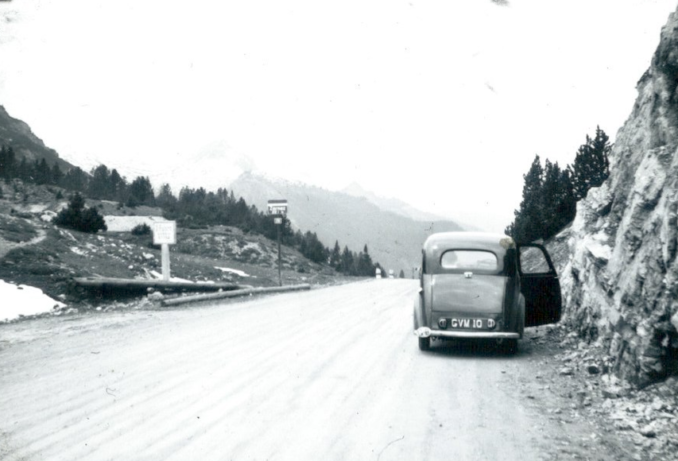
© Always Worth Saying 2022, Going Postal
At this point we have to acknowledge the inevitable. An uncomfortable truth has been following us during our trip through West Germany, Austria, Italy and now Switzerland. Eagle-eyed Puffins will have spotted the above car parked outside the Wilder Mann Sport Hotel at Steinach. As with Schrodinger’s cat, we must open the box and pronounce the heroic family Ford 8 (of Franco’s Spain, Gib and the Pyrenees fame) discovered dead and replaced by the Ford Popular, registration GVM 10, seen here at the top of the 6,778ft Ofen Pass.
Ofen Pass is also known as the Fuorn Pass and is a high Alpine crossing in the canton of Graubuden. Fuorn refers to the ironwork ovens used in the area the ruins of which can still be seen in the hills. It is also home to Europe’s biggest honey fungus which is about 800m wide and thought to be 1,000 years old
You can still stand on the exact same spot, but you will be knocked over. Behind the photographer is the Hotel Süsom Givè, a car park and a much better view. To the left of the old photograph is a road to an un-surfaced parking place from which trails span out over this part of the Alps. Have a look around via this link.
With all the photos so far being of transit, Puffins unfamiliar with the area will be wondering about a destination.
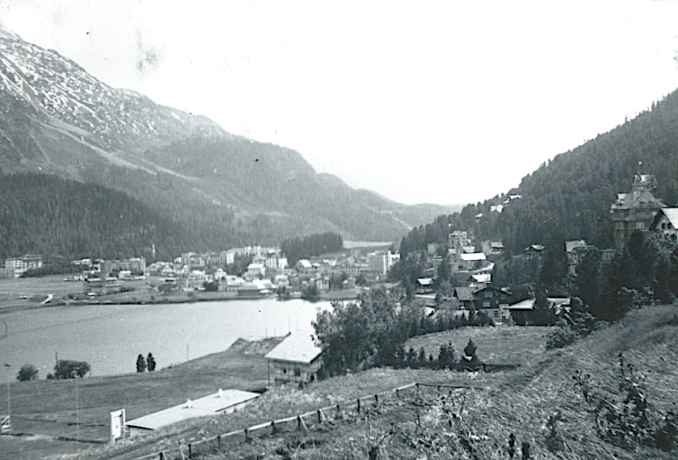
© Always Worth Saying 2022, Going Postal
With the built-up area visible from more than one lake and shorn of its usual photogenic winter setting, at first glance it might be difficult to locate the precise location for the above photograph. Fortunately, Puffins familiar with glitzy St Moritz will recognise in an instant the pitched tower roof of a building on the right which is the Badrutts Palace hotel. Since 1896 one of the world’s legendary hotels, a Gothic revival ode to Continental luxury no less, and still owned by the Badrutts family.
Previously we learned that the Hellenstainers invented Alpine tourism through a chain of hotels that included the Posta at Spondigna. Fans of Casper Badrutt maintain he single-handedly developed the concept of Alpine winter tourism at St Moritz in the late 19th century. Celebrities and monied guests were drawn to his lakeside palace. Greta Garbo and Aristotle Onassis were guests. Alfred Hitchcock honeymooned there. Newspaper adverts from the inter-war years claim this is where sport and fashion met, not least for August’s big golf events. A tennis professional was in attendance. Being 6,000ft above sea level not only allowed for pure air and full views of the lakes and mountains but for ‘English sanitation’.
According to The Tatler, as well as tennis and 18-hole golf there was riding, sailing and carbonic acid bath and mud bath cures. A Corvatsch Teleferique was in opperation. Then and now, all 157 rooms come with butler service and free ski lift tickets. Transfers to the railway station and airport are completed via the property’s own Rolls-Royce limousines. What hasn’t survived is the world’s first indoor tennis pavilion which is now Nobu Matsuhisa’s Japanese-Peruvian restaurant. Switzerland’s oldest nightclub, and ‘the hottest ticket in town’, The King’s Bar, is next door. Having said all of that, the Palace is a bit cringingly gaudy even by St Moritz standards.
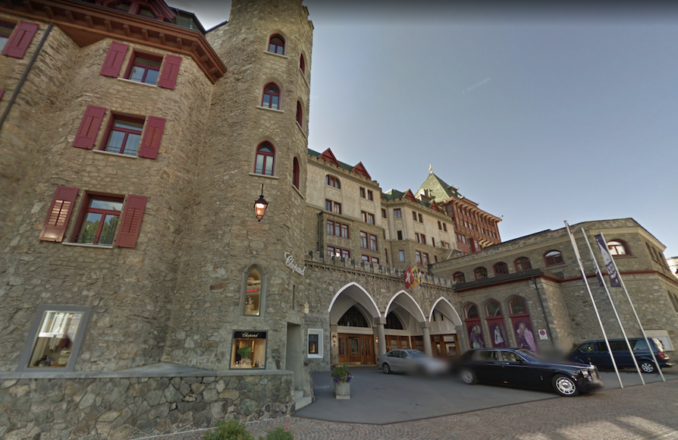
© Google Street View 2022, Google
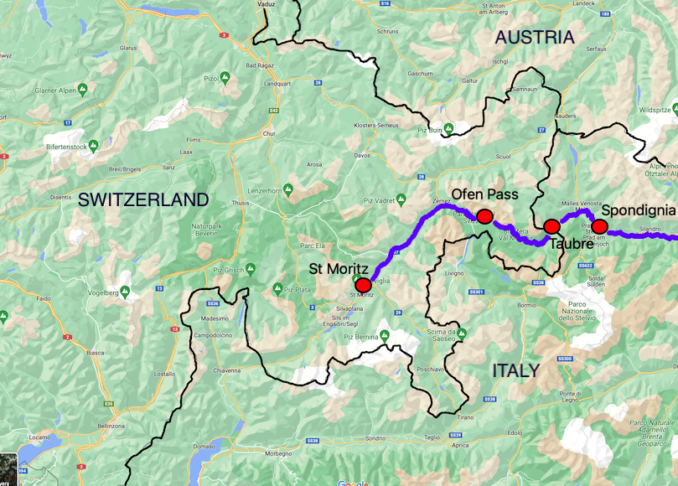
© Google Street View 2022, Google
Although I claim a family and personal (more of which later) connection with Switzerland, it is a bit tenuous. Other Englishmen do a better and what’s more address the border crossings, mountain passes and parking spaces outside exclusive hotels with Aston Martins rather than Ford Populars. Ian Fleming attended the University of Geneva and was at one time engaged to Monique Panchaud de Bottens of nearby Vaud. His creation, James Bond, was half Swiss. Although Fleming’s grandfather was Scottish, Bond’s Scottish father wasn’t introduced to readers until after the first of the films had been released, in order to explain Sean Connery’s big screen brogue. Bond’s Swiss mother, however, Monique Delacroix also from canton Vaud, contains more than a trace of autobiography.
The old Etonian was sent to Switzerland to finish his education in anticipation of the Foreign Office entrance exam, which he failed. After a career as a foreign correspondent and in banking, his entry into the secret world came at the outbreak of the Second War when he was recruited to Naval Intelligence at the legendary Room 39 of the Admiralty Building, despite no obvious qualifications other than being well connected.
After a good war, Fleming was a frequent visitor to Switzerland while writing the Bond books and short stories. Swiss locations appear both in print and on celluloid, via both fiction and real life. The original Dr No Bond girl, Ursula Andress was Swiss. The opening chase scenes of 1977’s The Spy Who Loved Me were filmed around St Moritz but captioned as a conveniently closer to the Iron Curtain Austria. At the end of the film’s opening, sheer granite cliffs are required with that part of the movie being filmed in Canada.
As we continue our road trip we will encounter some of the Connery Bond’s iconic locations but until then, unlike James in that DB5, we’re stuck amongst the cows at Vicosoprano.

© Always Worth Saying 2022, Going Postal
© Always Worth Saying 2022

